Around Ria Arousa
42:36.25N 08:56.00W Pobro do Caraminal
11th July. At this stage of the game we are starting to see yachts for a second time in new places and, quickly, distant waves become friendly chats and then visits to and from other yachts. The friendly Dutch couple we met in Portosin came to us while we were at anchor near them and offered us their dinghy: they had noticed us return with one of the flotation tubes well deflated on our dinghy. In the heat of the day, and because it was over-inflated, one of the seams had popped causing a leak.
Reminding me of the time quite a few years ago in Alderney when we split a float on a rock and had to row back to our boat on just the forward floatation chamber and the outboard hanging underneath the dinghy. We prioritised and made sure the duty free gin was safe before hauling the motor up on deck for a fresh water flush through, from which it recovered 100%. I was five months pregnant at the time.
Rob set to in the sunshine effecting a repair with glue and a patch. He was doubtful it would work.
“I have one hundred percent confidence in your skills my darling,” I encouraged him. It was partially effective but a bigger patch had to be placed over, and of course doubts have arisen as to whether all the seams are now suffering from tired glue.
It was very hot and windy at this anchorage off the beach, just outside the harbour and we watched with interest as two orange tugs wrestled a large tanker into the harbour, turning it around in the process, all upwind and just 200 mtrs from us.
In the morning we woke to find dozens of men and women in waders between us and the shore, dragging the seabed for cockles using long handled nets. Groups of tiny fishing boats powered with oars fished together and bigger boats with a crane aboard moored alongside an anchored and floating wooden vivero. Each boat sending big wire mesh baskets underwater to collect the next crop of mussels growing there.
The tender had only lost a little air so we pumped it up and took the pump ashore with us. We explored by foot before having a drink at the municipal market and returning to Zoonie to change ready for a swim and sun-bathe on the beach. Tough life is this, if you weaken.
The wind continued all night and into the next morning and having satiated our curiosity here we decided to move across to the city marina of Vilagarcia for what turned out to be a complete change.
18 Jul 2015
42:36.04N 08:46.20W Vilagarcia de Arousa
13th July. As soon as the efficient young marina lad guided us to a sheltered berth near the wall we found ourselves among numerous Irish and English cruising families all keen for a chat. An Irishmen referred to Oysters as “Built like brick s..t h…..s”, he is right and it is one of the things that gives us confidence in Zoonie.
Another Oyster, a 37 foot version of the same age as us, was a tri-part ownership and we got know Nick just before he and his two other crew flew back to Gatwick while Tagine awaited her next crew. Nick had sailed her from Kinsale in Ireland, and the final set of owners would set her on course for home.
This marina was cheap (£70 for 4 nights) very friendly and well used. Many brits lay up their boats here for the winter with confidence they will be safe and ready for their return next season.
While there was still some shade along the promenade we walked the mile or so to the charming little fishing village of Carril, passing more wading fisherfolk, sorting their generous catches on tables alongside the prom, cockle shells (Berberechos) being sorted and clattered into nets ready for sale at the nearby market.
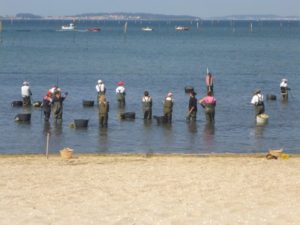
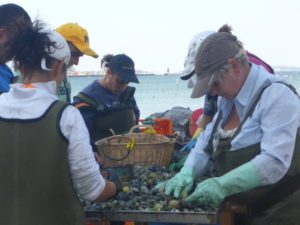

On wandering back along the prom past the marina and scanning the sea of metal masts, we spied a wooden one. Now in the heart of a traditionalist that always causes a minor stir and investigation was needed. Larry was designed by grandfather Nicholson (later Camper and Nicholson in Portsmouth) and built in Poole in 1907. Her sails were of gaff rig design with an eight foot bowsprit securing three foresails. I would not be able to close the fingers of my two hands around her rudder stock and her fairleads are the stoutest I have seen on a thirty eight footer. She is a labour of love, her wooden decks having to be kept wet to prevent shrinkage and leaks. ‘Lift outs’ were few and far between for her for the same reason, to avoid her wooden hull from drying and shrinking. For twenty years she has taken Sue and Christopher and their family all over the North Atlantic and strangely our paths nearly crossed when we were at Limehouse Basin earlier this year.
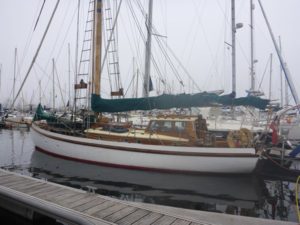
In the year of the 40th anniversary of the OSTAR Race (Observer Single-handed Trans-Atlantic Race) Sue and Christopher raced another yacht across the Atlantic from the mouth of the Beaulieu River to New York. So? You might ask. Well the catch is they turned their engine off at the Beaulieu fairway buoy and did not restart it until the Statue of Liberty beckoned them in! It took them 53 days against wind and current but what an immense achievement.
While anchored across the Ria last year Larry, with Sue, Christopher, children and grandchildren on board had two of her inflatable sailing dinghies stolen during the night. The police later informed them that they were most likely taken by South American drug-smugglers as this was the Ria most used for such illegal activities. Hence our visit a few nights before by the Aduanas Officers while we were in Riveira.
Larry had developed a suspicious leak which Christopher had traced to the stern gland where the propellor shaft passes out of the hull. Unfortunately a large generator had been installed on top and access to this crucial spot was now difficult so they had taken Larry around to another marina where she could be lifted out. Sue had left a note to this effect in our cockpit. However when we returned to Zoonie they were already back on the outer pontoon, or hammerhead. So we offered to take their lines should they want to bring Larry further in.
Well of course marinas were not invented in 1907 and since the bowsprit meant she had to be moored stern first, with her full length keel this was not going to be easy. The engine controls were near the floor of the cockpit, so Christopher could not see ahead while changing gear. It was essential for Sue to tell him when to reverse. With the tiller hard over Larry slowly made her way backwards into the space with Rob and me ready to take her lines, showing not only Christopher’s skill but also the excellent communication between them both.
16th July. While happily secured in this marina we decided to visit the Illa Arousa by bus to see a little of the countryside and view the water from on land, another dimension you might say. We sped at what seemed like great speed across the long modern bridge that traverses shallows to the (almost) island. In the heat of the day an English speaking Tourism Guide said we could walk around the island in an hour or so but we chose to climb to the mirador and enjoy the view through Jesus’ eyes on top of his granite rock before exploring the fish quay and settling in one of the bars for a fish lunch.
English was not spoken by the waiters but I found common ground with one of them in French and thought I was doing so well until, after we were full up with pureed muscle and potato croquettes, a plate of octopus (pulpo) on boiled potatoes was produced. Not knowing how to confess my language shortfall we tucked in.
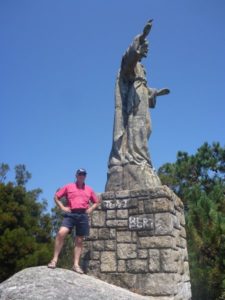
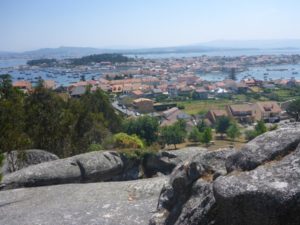
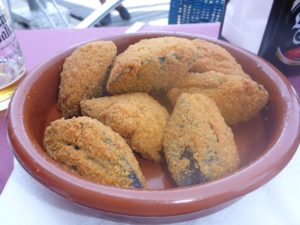
That evening, after drinks and nibbles on Larry, we all decided to go for a meal at the marina along with the three crew, two Cambridge students and their skipper, Richard from another yacht. Seven of us sat around a round table and chatted together over salty calamari, salad and roasted green peppers washed down with Galician wine. A memorable happy evening.
17th July. Time to move on. We motored in a flat, windless calm down the Ria towards the sea past bunches of flowers left over from the fiesta of the Virgen del Carmen the day before and made our way to San Vicente, just outside the Ria. Larry had been there, so although the guide book said there is not much more than a walk to a headland we thought we’d take a look anyway. What a strange place. Luxury holiday apartments gave an air of exclusivity to the harbour where yachts were left and rotting at their moorings. Lines almost chafed through and a furled headsail in tatters, ribbons of sail material blowing in the wind. The place seemed deserted when we arrived, like a ghost town of lost inhabitants. Would we be sucked into obscurity too? Not at their prices. We decided to stay only one night and pack the walk and a swim into what was left of the day.
